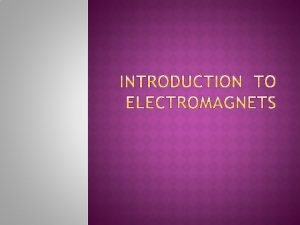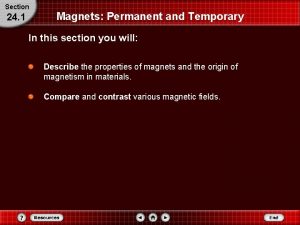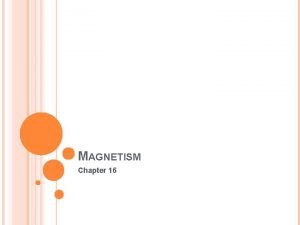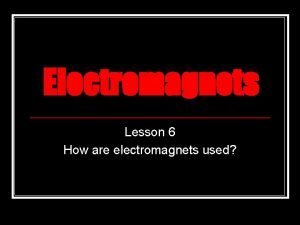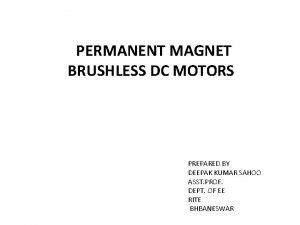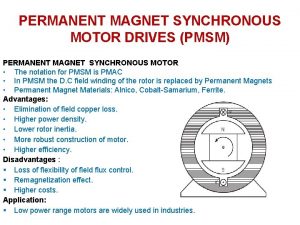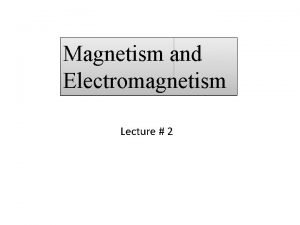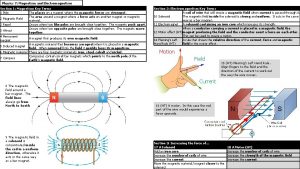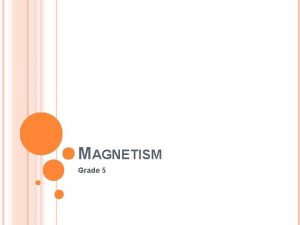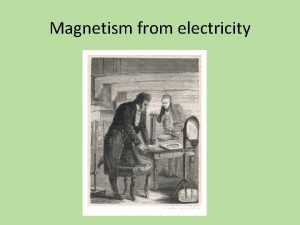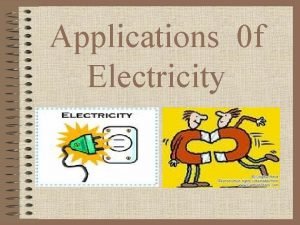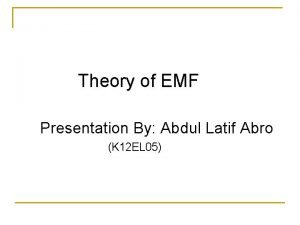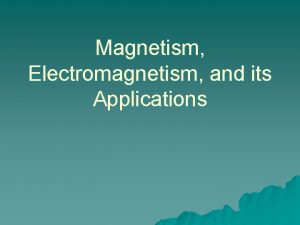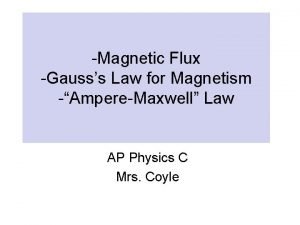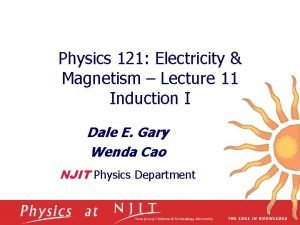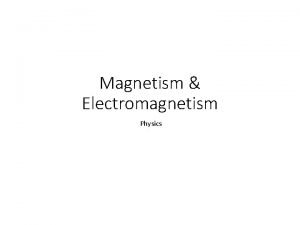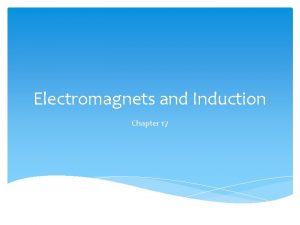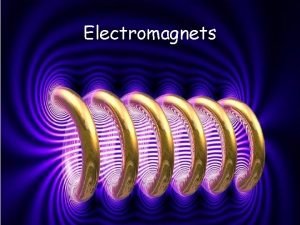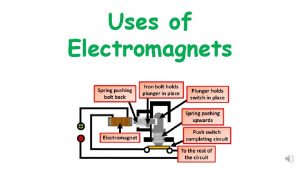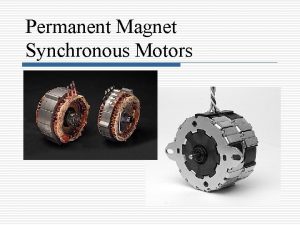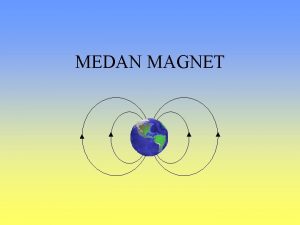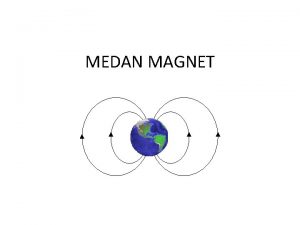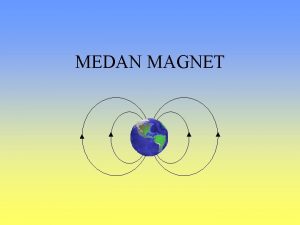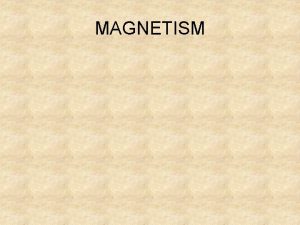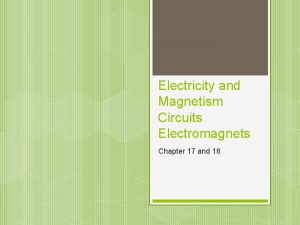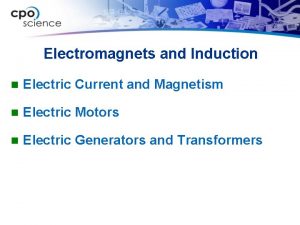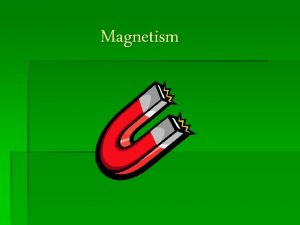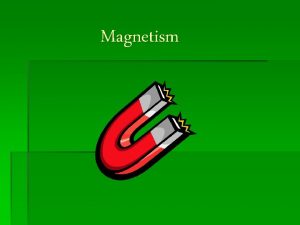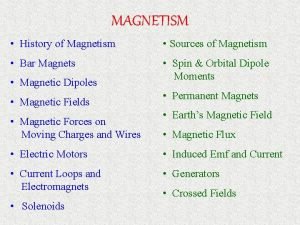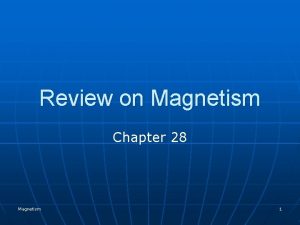Magnetism and Electromagnets Permanent Magnet A permanent magnet


























- Slides: 26

Magnetism and Electromagnets

Permanent Magnet • A permanent magnet is a material that keeps its magnetic properties, even when it is not close to other magnets.

Poles • All magnets have two opposite magnetic poles.

Attraction

Magnetic Fields • Magnetic field lines always point away from a magnet’s north pole and toward its south pole.

• What does the direction of magnetic field lines tell you? • Magnetic field lines point in the direction of the force from the north pole.

Magnetic Declination • The difference between the direction a compass points and the direction of true north.

Earth’s Magnetism • Huge electric currents flowing in the molten iron produce the Earth’s magnetic field (like an electromagnet!).

Gauss • The unit to measure the strength of a magnetic field. • Earth’s magnetic field averages about 0. 5 gauss at the surface.

Electromagnets • Magnets created by electric current flowing in wires.




Electromagnet Poles • “right-hand-rule”

Advantages • You can switch an electromagnet on and off by switching the current on and off. • You can switch an electromagnet’s north and south poles by reversing the direction of the current in the coil. • The strength can be changed by changing the amount of current in the coil. • Can be much stronger than permanent magnets when using large currents.


• http: //www. howstuffworks. com/electromagnet. htm • https: //www. youtube. com/watch? v=gz. CXowhks 80

Paramagnetic • Classified as nonmagnetic • Magnetism of individual electrons do not cancel completely. • Alignment of poles varies from atom to atom • The total magnetic field averages to zero. • Examples: ▫ Aluminum ▫ Many chemicals

Ferromagnetic • Very strong magnetic properties. • Examples: ▫ Iron ▫ Nickel ▫ Cobalt

Soft Magnet • A material that is easy to magnetize but loses its magnetization easily too. • Examples: ▫ Steel • Heat, shock, and other magnet can demagnetize steel.

Hard Magnets • Magnetism tends to remain aligned for a long time. • Demagnetized with high temperatures

Use right-hand-rule to describe the north and south pole.

• Materials in which each atom has a tiny magnetic field, but the north and south poles of atoms within the material are randomly arranged so that the magnetic fields cancel out, are known as: a. nonmagnetic. b. paramagnetic c. diamagnetic. d. monomagnetic.

• If you reverse the direction of current flow in an electromagnet: a. the north and south poles are reversed. b. the magnet is neutralized. c. the strength of the magnetic field increases. d. a short circuit occurs.

• An example of a ferromagnetic material is a: a. ceramic mug. b. nail attracted to a bar magnet. c. penny. d. CD.

• Which of the following creates a magnetic field? a. A metal ball with 2 coulombs of static charge on it b. A piece of aluminum c. A coil of wire carrying current d. A diamagnetic material
 Temporary vs permanent magnets
Temporary vs permanent magnets What happens when you break a magnet in half
What happens when you break a magnet in half What are properties of magnet
What are properties of magnet Magnetic field of two magnets
Magnetic field of two magnets Electromagnets in doorbells
Electromagnets in doorbells Kutub a dan b adalah
Kutub a dan b adalah Blpm classified as
Blpm classified as Pmac drives
Pmac drives Physics 102 electricity and magnetism
Physics 102 electricity and magnetism Ib physics topic 5 questions
Ib physics topic 5 questions Electricity and magnetism lecture notes
Electricity and magnetism lecture notes Artificial magnet example
Artificial magnet example Electricity and magnetism jeopardy
Electricity and magnetism jeopardy Sph3u electricity and magnetism
Sph3u electricity and magnetism Magnetism and electromagnetism
Magnetism and electromagnetism Electromagnet experiment hypothesis
Electromagnet experiment hypothesis Intensity of magnetisation
Intensity of magnetisation Magnetism grade 5
Magnetism grade 5 Electricity and magnetism
Electricity and magnetism Electric fuse and circuit breaker graphic organizer
Electric fuse and circuit breaker graphic organizer Electricity and magnetism
Electricity and magnetism Abro orientation
Abro orientation Magnetism and electromagnetism
Magnetism and electromagnetism Gauss law in magnetism
Gauss law in magnetism Electricity and magnetism
Electricity and magnetism Electricity and magnetism
Electricity and magnetism Electricity and magnetism vocabulary
Electricity and magnetism vocabulary
